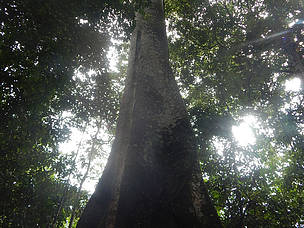By Louvier Kindo Tombe
Extracting the ‘Njangsa’ seed can be quite demanding.
“If you are not patient enough, you can not harvest the fruits from the bush”, Says Mama Mitop, a Bantu woman specialized in extracting ‘Njangsa’ in the East region of Cameroon.
“Harvesting is even the easiest part of the extraction process”, she continued.
‘Njangsa’ is a nutty spice that is widely used in Cameroon for flavouring and thickening of food. The seeds are brownish yellow, round and some measuring 1 cm in diameter. They are oily in texture with an oudor reminiscent of oily chocolate, but their flavour is truly unique, subtle aromatic with a mild bitter aftertaste.
The ‘Njangsa’ seeds (kernels) are found inside a fruit that grow on a tree mostly found in the more open parts of the forest zones in Africa.
The tree itself is equally known as ‘Njangsa’ (Cameroon), Munguella (Angola), Bofeko (Zaire), Wama (Ghana), Okhuen (Nigeria), Kishongo (Uganda), and Akpi (Ivory Coast),
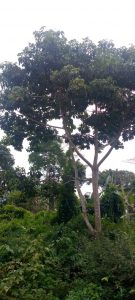
Reports show that ‘Njangsa’ was only actively domesticated since 1995, but today it is virtually in every country in the world.
The spice is among the most economically important indigenous fruit species in the country and beyond, accounting for a significant proportion of local trade in Non Timber Forest Products (NTFPs).
In Cameroon, the indigenous communities are noted for the extraction of ‘Njangsa’ inside the forest.
“We do not climb on the trees, we only pick the fruits when they are ripe enough and drop,” Mama Mitop said.
The ‘Njangsa’ tree can grow between 20 to 50 m high with straight trunks that has a diameter of approximately 2.7m. it has a grey-coloured smooth bark that turns red when cut.
There are periods that the trees start to drop their fruits, indicating the beginning of harvest.
“October ending or early November is when we usually take the trip to the bush to harvest the ‘Njangsa’ fruits,” Mama Mitop told this reporter during a visit in Gribe, a Bantu village in the Boumba and Ngoko Division of the East region of Cameroon.
In the East region, the collection or harvesting of the ‘Njangsa’ fruits is not done on one spot.
“At times we cover distances of over 5 kms in the forest before we can find a tree that has dropped most of its fruits,” says Dorina, another Bantu woman specialized in ‘Njangsa’ extraction.
“When we enter the forest, we set up camps, and we spend up to about 2 weeks picking the fruits before returning to the village,” she said, and the reason being that “we want to return home with a reasonable quantity that we can sell and make good profit”.
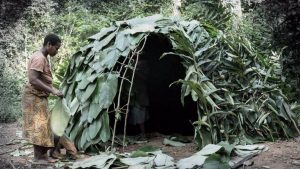
While in the forest, the indigenous people do not only pick up the’Njangsa’ fruits, but equally harvest other Non Timber Forest Products (NTFPs) like Colanuts, bush mango, Okok, …etc, to maximize profit.
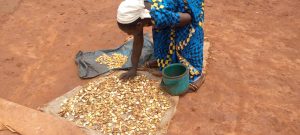
The harvesting phase of the fruits is the most dangerous because “we are exposed to snake bites, and other harmful insects in the forest”, Madam Mitop said.
The forest is always bushy, “and we have to find our way through thin and thorn to harvest, coming in contact with wild animals in some aress”. She says “one other major obstacle is access to the forest, as they are constantly been chased away for one reason or the other.
One ‘Njangsa’ tree it should be noted bears about 4000 fruits per season. It can take one month to drop off the ripe fruits.
The indigenous communities in the East region of Cameroon mostly process the ‘Njangsa’ fruits manually in order to extract the seeds.
“After harvesting, we throw the fruits in one corner of the house, place dead leaves on it, pour water and allow to ferment and rot,” Madam Mitop explained.
In some cases, the fruits get rotten on the ground even before they are picked.
Some people will prefer to lump the fruits but in the forest and allow to rot. Most prefer to ferment the fruits where they can easily have access to water, which is vital in the next stages of the process.
The fermentation period is estimated at an average of one week, but can extend depending on the availability of the owner of the fruits given hat the indigenous people are into multiple activities at a time.
The big green kidney-shaped fruits are then soaked with water to decompose so that the fleshy parts can easily peel off. This will normally take days.
Because of water challenges in the Bantu and Baka communities, the indigenous people usually load the fruits inside bags and soak in a running stream around.
“We prefer streams because when the fruits have decomposed enough, we would just wash them directly in the stream,” Mama Mitop said. According to her, “washing the fruits is one of the most difficult part in the process“. It is not too different from that of bitter leaf, commonly called ‘Ndole’.
“We put the fruits in bags and hit against the stones in the stream with our hand to force the fleshy part to dis-integrate from the seed, the we rinse,” she said adding that; ” we repeat the same process over and over about three times until we get the seed coats.
The ‘Njangsa’ seed coats are usually black in colour when extracted from the fleshy part of the fruit.
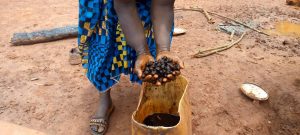
The seed coats are then boiled. The boiling is not done just anyhow.
“Usually, we boil in the evening and allow to spend the night on fire, in the morning we wash again with clean water and boil all day,” Mama Mitop told us.
The second boiling is done until the seed coats start to crack inside the water. It takes vigilance to discover when this phase is over, as Mama Mitop explains;
“We know that it is ready when we start hearing cracking sounds from the seed coat. We can then remove and allow to cold before we start extracting the seeds from its coat.”
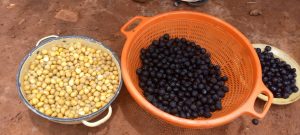
The ‘Njangsa’ seed is the final product in the process. But it’s extraction is the most difficult part in the entire process. The indigenous communities use materials (like a knife or nail) to crack out the seed from the coat. To use a nail as it was usually done in the past, it has to first of all be adapted to take the shape of a knife.
“We crack the coats one after the other and that is very challenging, at times to crack one bucket of 5 litres, personally I take two days,” Mama Mitop said.
“During the boiling process, not all the coats crack, and when we are extracting the seeds we face difficulties and we are forced to used stones to force open a crack on the seed coat,” she further explained.

Once extracted, the ‘Njangsa’ seed is ready for consumption. But it has to be dried in order for it to be preserved for a longer period.
Well dried ‘Njangsa’ seed can stay for as long as you want according to research studies which shows that ywo main drying methods exist.
“When you allow the seed to get dry under the sun, it taste better than when you dry it using smoke from the fireside,” nutrition experts say.
To facilitate the extraction of ‘Njangsa’ in Cameroon, access into the forest has to be facilitated for the indigenous communities, but in the Boumba and Ngoko Division, like elsewhere, that is not always the case.
Difficult Access to Non Timber Forest Products (NTFPs)
The indigenous people in every Bantu or Baka community in Cameroon are faced with the challenge of accessing the forest to harvest Non Timber Forest Products.
“Denying us access into the forest is killing us silently,” Lessa Blaise, a Baka Chief told News Upfront.
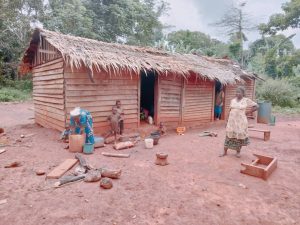
Lessa Blaise, is chief of Elandjo’o community in Yokadouma, Boumba and Ngoko Division of the East region of Cameroon.
Eco guards are always preventing them from entering the forests especially protected forest areas, like the Nki National Park among others.
The Baka and Bantu communities rely solely on Non Timber Forest Products for survival.
It is thus under difficult conditions that they succeed to pick and extract ‘Njangsa’ seeds.
“When they meet us in the forest, they beat us, they often break into our homes destroying our belongings threatening to shoot us with a gun if we dare enter the forest again,” Mama Mitop revealed.
The situation has made the communities not to be able to extract 1/10 of ‘Njangsa’ fruits found in the forest.
“Most of the trees with enough ‘Njangsa’ fruits are found inside protected forest zones which we can’t access,” Chief Lessa added.
Some Non Governmental Organizations (NGOs) are working closely with the indigenous communities and the government to help facilitate access into the forest for the indigenous communities.
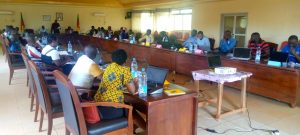
Green Development Advocate (GDA) is one of such organizations. Their actions in collaboration with AAFEBEN, an organization that supports women in the Boumba and Ngoko Division have led to the signing of a memorandum of understanding between the government and the association of Baka Communities (ASBABUK).
“I thank ASBABUK for what they have done for us, but we expect more,” Chief Lessa Blaise told this reporter.
GDA and AAFEBEN are members of the RACOPY Platform that facilitated the signing of the MOU between the Government and ASBABUK.
The Pygmy Concerted Action Research Network (RACOPY) was founded in 1996 in response to the stigmatization of indigenous peoples in particular and to support the various groups of indigenous forest peoples (PAF), especially the Baka, Bakola, Bagyeli, Bedzang in the defense of their rights.
GDA wants the government to revise some texts and laws governing the Non Timber Forest Products sector.
Some of the texts make it difficult for them to harvest the products in the forest, while others make it difficult for them to market the products.
Marketing Challenges
The extraction of ‘Njangsa’ seeds becomes more challenging when the market is not visibly fruitful.
The indigenous communities that extract the seeds, do not directly take them to the market. ‘Buyam Sellams’ are the ones that get to the communities to buy from them and take to the market.
“We do not master the price in the market in big cities, so when they come here, they are the ones who fix the prices,” Madam Mitop laments.
The worst part of it is that “they always buy at very cheap rates“, she added.
Some buyers even pre-finance the extraction process to secure the products when they are ready for sale.
“We need money to buy food items and other needs as we go and camp in the forest to harvest the fruits, when we collect their money, they fix the selling price and we are forced to adhere,” Chief Lessa corroborates.
“At our level, we sell a container of say 2 litres (Combo No. 20) at FCFA 3.000, but those who pre-finance us usually get it at FCFA 1.500,” the indigenous people revealed.
In big cities like in Yaounde and Douala, a cup of ‘Njangsa’ is sold at say FCFA 650 to 700. The ‘Buyam Sellams’ are the ones who make big money from ‘Njangsa’ trade. The trade it should be noted is reserved only for licenced individuals. The indigenous communities are actually not allowed to market the seeds in great quantity.
These are some of the lapses in the laws and texts that Green Development Advocate (GDA) and partners wants the government to revise.
‘Njangsa’ seeds it should be noted are exported in great quantity out of the country. Reports indicate that machines are gradually being introduced in the extraction process. One of such machines specialized in cracking the seeds from the seed coats was recently implanted in the Boumba and Ngoko Division though it’s not completely functional.

The marketing of ‘Njangsa’ is sustainable because only the ripe fruits are collected. The tree is not destroyed in the process.
Myths and Other Uses of ‘Njangsa’
There is no doubt that we are blessed and surrounded by countless plants and trees that offer numerous benefits to us. However, the call to action is for us all to regularly acknowledge these amazing plants so as to completely gain all the benefits they offer to us.
Cameroon ‘Njangsa’ is highly cherished because apart from being used a local spice, the oily seed tree is also used for several medicinal purposes.
The bark and leaves of the tree are used in different ways to cure varied diseases.
In Sierra Leone, it is tied warm to the body to cure elephantiasis, in Liberia, pregnant women take the liquor to relieve pains and prevent miscarriage. In Gabon, it cures painful menstruation and serve as a poison antidote. In Nigeria, it is mixed with pepper and salt for the treatment of constipation, while most Central and West Africa countries use it to treat diarrhoea, dysentery, leprosy and anaemia.
A number of myths surround the tree including the belief that a diseases known as ‘collar crack’ will occur on a cocoa farm if the tree is cut down and that application of bark ash to the faces of hunters in Liberia/Ivory Coast, enables them to kill all the elephants they see.
In Cameroon, the seeds while still in its coat is used in a local game known as “Songo’oh”.





